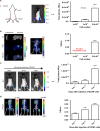Tracking of dendritic cell migration into lymph nodes using molecular imaging with sodium iodide symporter and enhanced firefly luciferase genes
- PMID: 25974752
- PMCID: PMC4431315
- DOI: 10.1038/srep09865
Tracking of dendritic cell migration into lymph nodes using molecular imaging with sodium iodide symporter and enhanced firefly luciferase genes
Erratum in
-
Corrigendum: Tracking of dendritic cell migration into lymph nodes using molecular imaging with sodium iodide symporter and enhanced firefly luciferase genes.Sci Rep. 2015 Oct 9;5:14397. doi: 10.1038/srep14397. Sci Rep. 2015. PMID: 26449533 Free PMC article. No abstract available.
Abstract
We sought to evaluate the feasibility of molecular imaging using the human sodium iodide symporter (hNIS) gene as a reporter, in addition to the enhanced firefly luciferase (effluc) gene, for tracking dendritic cell (DCs) migration in living mice. A murine dendritic cell line (DC2.4) co-expressing hNIS and effluc genes (DC/NF) was established. For the DC-tracking study, mice received either parental DCs or DC/NF cells in the left or right footpad, respectively, and combined I-124 PET/CT and bioluminescence imaging (BLI) were performed. In vivo PET/CT imaging with I-124 revealed higher activity of the radiotracer in the draining popliteal lymph nodes (DPLN) of the DC/NF injection site at day 1 than DC injection site (p < 0.05). The uptake value further increased at day 4 (p < 0.005). BLI also demonstrated migration of DC/NF cells to the DPLNs at day 1 post-injection, and signals at the DPLNs were much higher at day 4. These data support the feasibility of hNIS reporter gene imaging in the tracking of DC migration to lymphoid organs in living mice. DCs expressing the NIS reporter gene could be a useful tool to optimize various strategies of cell-based immunotherapy.
Figures





Similar articles
-
Tracking dendritic cell migration into lymph nodes by using a novel PET probe 18F-tetrafluoroborate for sodium/iodide symporter.EJNMMI Res. 2017 Dec;7(1):32. doi: 10.1186/s13550-017-0280-5. Epub 2017 Apr 4. EJNMMI Res. 2017. PMID: 28378292 Free PMC article.
-
Optimization of Dendritic Cell-Mediated Cytotoxic T-Cell Activation by Tracking of Dendritic Cell Migration Using Reporter Gene Imaging.Mol Imaging Biol. 2018 Jun;20(3):398-406. doi: 10.1007/s11307-017-1127-1. Mol Imaging Biol. 2018. PMID: 29027077
-
Dual reporter gene imaging for tracking macrophage migration using the human sodium iodide symporter and an enhanced firefly luciferase in a murine inflammation model.Mol Imaging Biol. 2013 Dec;15(6):703-12. doi: 10.1007/s11307-013-0645-8. Mol Imaging Biol. 2013. PMID: 23677652
-
Dendritic cell migration through the lymphatic vasculature to lymph nodes.Adv Immunol. 2013;120:51-68. doi: 10.1016/B978-0-12-417028-5.00002-8. Adv Immunol. 2013. PMID: 24070380 Review.
-
Tracking dendritic cells in vivo: insights into DC biology and function.Immunol Res. 2004;29(1-3):69-80. doi: 10.1385/IR:29:1-3:069. Immunol Res. 2004. PMID: 15181271 Review.
Cited by
-
Effects of Adoptive Transfer of Tolerogenic Dendritic Cells on Allograft Survival in Organ Transplantation Models: An Overview of Systematic Reviews.J Immunol Res. 2016;2016:5730674. doi: 10.1155/2016/5730674. Epub 2016 Jul 28. J Immunol Res. 2016. PMID: 27547767 Free PMC article. Review.
-
In Vivo Generation of Gut-Homing Regulatory T Cells for the Suppression of Colitis.J Immunol. 2019 Jun 15;202(12):3447-3457. doi: 10.4049/jimmunol.1800018. Epub 2019 May 3. J Immunol. 2019. PMID: 31053627 Free PMC article.
-
Tracking dendritic cell migration into lymph nodes by using a novel PET probe 18F-tetrafluoroborate for sodium/iodide symporter.EJNMMI Res. 2017 Dec;7(1):32. doi: 10.1186/s13550-017-0280-5. Epub 2017 Apr 4. EJNMMI Res. 2017. PMID: 28378292 Free PMC article.
-
Dendritic Cell Trafficking and Function in Rare Lung Diseases.Am J Respir Cell Mol Biol. 2017 Oct;57(4):393-402. doi: 10.1165/rcmb.2017-0051PS. Am J Respir Cell Mol Biol. 2017. PMID: 28586276 Free PMC article. Review.
-
Optimization of Dendritic Cell-Mediated Cytotoxic T-Cell Activation by Tracking of Dendritic Cell Migration Using Reporter Gene Imaging.Mol Imaging Biol. 2018 Jun;20(3):398-406. doi: 10.1007/s11307-017-1127-1. Mol Imaging Biol. 2018. PMID: 29027077
References
-
- Cella M., Sallusto F. & Lanzavecchia A. Origin, maturation and antigen presenting function of dendritic cells. Curr. Opin. Immunol. 9, 10–16 (1997). - PubMed
-
- Hart D. N. Dendritic cells: unique leukocyte populations which control the primary immune response. Blood 90, 3245–3287 (1997). - PubMed
-
- Steinman R. M. The dendritic cell system and its role in immunogenicity. Annu Rev Immunol. 9, 271–296 (1991). - PubMed
-
- Ardavin C., Amigorena S. & Reis e Sousa C. Dendritic cells: immunobiology and cancer immunotherapy. Immunity 20, 17–23 (2004). - PubMed
-
- De Vries I. J. et al. Effective migration of antigen-pulsed dendritic cells to lymph nodes in melanoma patients is determined by their maturation state. Cancer Res. 63, 12–17 (2003). - PubMed
Publication types
MeSH terms
Substances
LinkOut - more resources
Full Text Sources
Other Literature Sources

